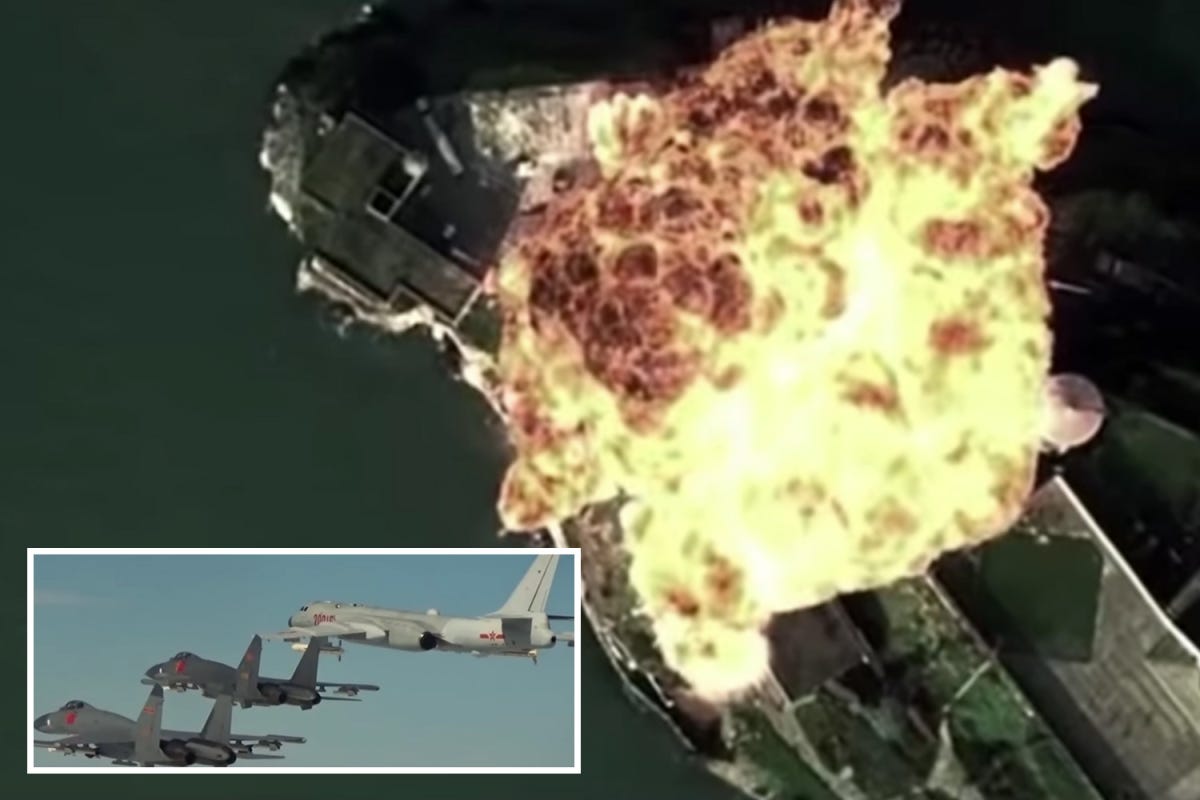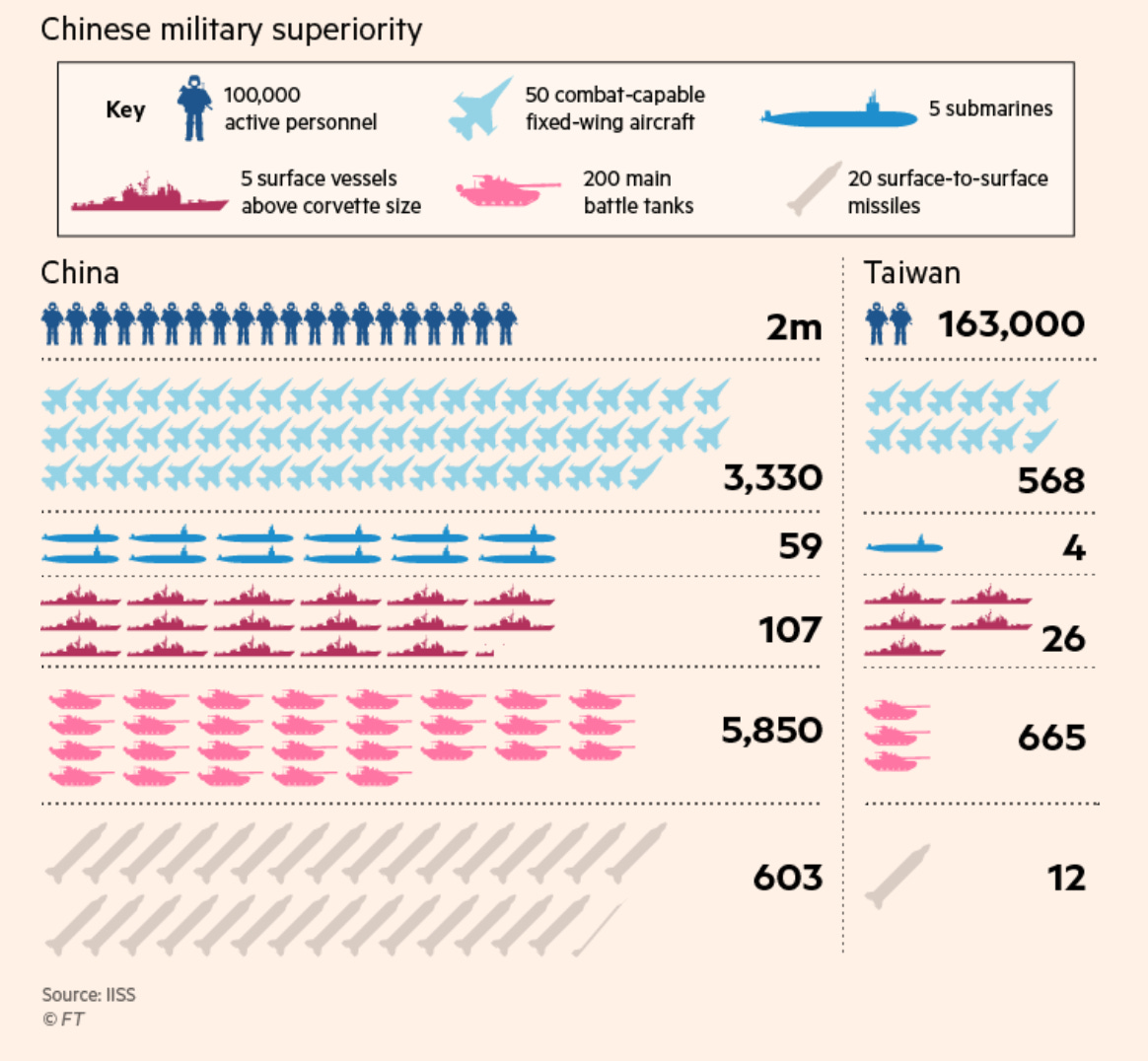China wants to conquer Taiwan, not the world. For now.
Despite the rhetoric and the chances of clashes elsewhere, there's only one place that war between the two giants is likely to happen.
In September this year the Chinese air force released a two-minute propaganda video called "The God of War H-6K Goes on the Attack!". It showed nuclear-capable Chinese H-6K bombers destroying what appeared to be an American air force base on the Pacific island of Guam.
The well-lit backdrops, the jerky, arty directional style, and the CGI-infused action sequence were reminiscent of Hollywood. Perhaps too reminiscent, because it wasn’t long before commentators online realised that much of the video had been lifted from Hollywood blockbusters including "The Hurt Locker", "The Rock", and "Transformers: Revenge of the Fallen." Stung by a level of international pushback that bordered on mockery, the video was quietly taken down.
The question is, was there anything to the video’s message? Is China about to aggressively challenge American or Western targets?
Or is the Chinese military, like the video itself, more for show?

The last time the People’s Liberation Army (PLA) went to war was in 1979, when nearly half a million Chinese soldiers engaged in the euphemistically named “Self-Defensive Counterattack Against Vietnam”. It was not a good war for the PLA. Facing a Vietnamese force a tenth its size, the Chinese military was bogged down in vicious fighting that left tens of thousands dead and a ceasefire just a month later.
Chinese military confidence was undermined further over the next few decades with the realisation that they were nowhere near the level of their major strategic competitor, the US. The first evidence of this came in the 1990-91 Gulf War, when the Iraqi Army, with similar doctrine and equipment to the PLA, was destroyed in just 100 hours by the US-led allies. Chinese military inferiority was heightened in 1996 when the US dispatched two aircraft carrier groups to the seas of Taiwan to show America’s commitment to the island’s defence. The PLA couldn’t even locate the carriers, let alone fight them.
Since then, and in particular under President Xi, the PLA has been heavily invested in. China’s official defence budget for 2020 is reported to be $237 billion, second only to America’s, but there are suspicions that this could be much higher, perhaps up to 87% of the Pentagon’s. This gives a figure of approximately $652 billion, about the same size as Switzerland’s total GDP.
Most of this has been spent on new equipment.
The People’s Liberation Army Navy (PLAN) has expanded rapidly, to the extent that for the first time since the Second World War the US Navy is no longer the world’s biggest.
Its air force, already one of the largest, is rolling out new stealth fighters that they believe are a match for the F35 aircraft that the US, the UK, Japan, and other allies are pinning their hopes on.
China is also ploughing money into non-conventional warfare, developing new killer technologies above and beyond most other nations. The country is already the world’s leading exporter of military drones, and has created so-called “carrier killer” missiles to nullify the threat from America’s eleven giant carrier groups. The country has a new space force, and is considered to have substantial cyberwarfare strengths.
There is a point to all this military investment.
As the US Department of Defense notes, the official reason for this heavy spending is for the PLA “to become a ‘world‐class’ military by the end of 2049…[one which is] equal to—or in some cases superior to—the US military”.
But with what aim? Is it to take over the world, or something closer to home? The PLA in fact seems to have two main areas of focus, global and domestic.
In terms of its international reach, the PLA has a long way to go to match the West. It currently has just one confirmed extra-territorial base (not including the South China Seas), in the African country of Djibouti. Although there is talk of China wanting to open more, including in Western allies like Israel and the UAE, it will still be a long way behind the West. Britain and France have a few dozen foreign bases between them; America, on the other hand, has up to 800 bases across 80 countries, which include 377,000 personnel in Pacific Command alone.
China simply doesn’t have much experience fighting outside of its immediate neighbourhood. Although Chinese troops have mounted expeditions across maritime Asia over the centuries, from Japan to Java and Johor, a Chinese army has never been further west than the borders of Kazakhstan and Kyrgyzstan. There, at the Battle of Talas in AD751, Imperial Chinese forces were defeated by an alliance of Arabs and Tibetans. It was an event that marked the end of the Middle Kingdom’s expansion into Central Asia, and which is said to have led to paper being introduced, via captured Chinese soldiers, into the West.
Instead, by far the PLA’s most important role is is to defend China’s territorial integrity. This is a demanding task given how many land and sea boundaries the country has – and how many of these boundaries are in contention. China currently has border disputes with countries including Japan, Vietnam, Philippines, Malaysia, Korea (North and South), Russia, and Bhutan, to name just a few, plus of course the most deadly of all in recent years, that with India. In May this year Chinese troops, reportedly chosen for their martial arts ability, ambushed an unarmed Indian Army patrol on the border and beat twenty soldiers to death with clubs and stones.
However, none of these are as important as the main “domestic” challenge for the PLA: Taiwan. President Xi is determined to force the reunification between the Mainland and what the Communist Party considers to be a rogue island province, at a time no later than 2049 when China will be celebrating the centenary of the founding of the People’s Republic.
For a long time, Beijing sought to reclaim ownership through diplomacy, but this may have now changed: earlier this year Chinese Premier Li Keqiang left out the word “peaceful” when referring to Beijing’s desire to “reunify” with the island.
On the face of it this should be worrying for Taiwan, whose armed forces are dwarfed by those on the mainland (see the infographic below).
Yet for all China’s bluster, invading Taiwan would make D-Day look like an afternoon regatta. As this analysis shows, Chinese forces would have to make it across a hundred mile stretch of sea and successfully invade a mountainous island that’s had seventy years to prepare. Given the hundreds of thousands of troops needed to make a success of it, a build-up to any invasion would also be easy to spot.

Far more likely would be for China to seize some of the outlying Taiwanese islands and see what happened next. Would, for instance, the US intervene?
Whilst America doesn’t have a legal requirement to come to Taiwan’s aid, it has recently re-committed its support to the island nation, sentiments backed up by arms sales. If the US did want to fight on Taiwan’s behalf, then it has enough assets in the region (including submarines) to make it very tough indeed for a Chinese invasion force to even reach Taiwan, let alone conquer it.
Whether the PLA is able to launch a full invasion of a Taiwan under US protection is hard to tell. What is for sure is that Beijing is investing in its armed forces to signal its ability to try, and that may be enough to persuade future American Presidents that Taiwan isn’t worth the effort. As Sun Tzu once said, “The supreme art of war is to subdue the enemy without fighting.”
Avoiding a war would be handy for China given the questions over its military proficiency. Almost all the China watchers that I have spoken to agree that the PLA is not yet strong enough to challenge America and its allies in open warfare. Years of combat inactivity take a long time to correct, especially against Western forces that have been more at constant war for decades in various parts of the world. Their equipment also heavily lags behind in capability, despite years of investment: a third of China’s fighters are second generation planes, which were phased out by the US years ago.
This is not to say there might not be skirmishes between the two sides. US and Chinese forces have already clashed in the past (like the spy plane incident of 2001), and with a lack of naval protocols in the South China Sea, there may be more to come. A Chinese vessel ramming a Western naval ship is not an unimaginable scenario, and something to consider for those countries intent on performing Freedom of Navigation patrols there, like the UK and Australia.
However, the one realistic location for actual war to start is around Taiwan. With Beijing having put so much store into reuniting the two sides of the Straits, it is hard to see how there won’t be a military push to retake the island if diplomacy breaks down. If China does invade, then all eyes will be on America and its allies to see how they respond.
Until such a day, however, it is more than likely that the only US-Chinese combat on display will be on intellectual property-defying propaganda videos.
********
NEXT WEEK: Assuming all goes to plan we will be looking at China’s ambitions in Africa with a special guest. If not, then something else. I’m currently working on a list of books about China for Christmas so expect to see that soon too.
PLEASE SHARE: If you like what you read then please do share with one or two people - the more people understand about Chinese-Western relations, the better. Thanks!



